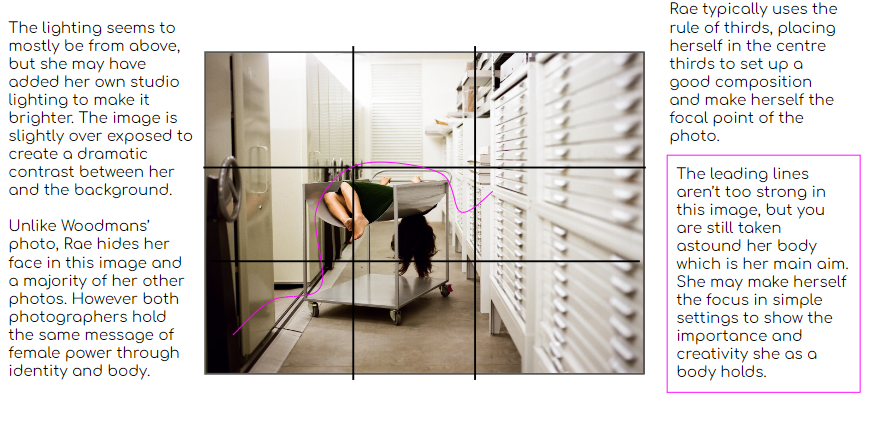
Francesca Woodman is known best for her non-traditional self portrait images. There is a regular pattern of semi-nudity that is half hidden and obscured. She uses furniture, or hides herself through a long exposure to blur her body. She was born in Colorado in 1958, and began shooting in her early teenage years whilst at boarding school. During this she managed to shoot around 800 photos. Due to the fact her father was a printer and photographer meant she was brought up in an environment where making and talking about art were part of everyday life. She was influenced by European culture and had a significant impact on her artistic development. Surrealist art and Claud Cahun are also seen through her work as an influence. Woodman later took her life at the young age of twenty-two.
Her images hold a delicate sense due to their small scale, and convey an underlying sense of human fragility. It creates a personal sense to her work. Most of her images are shot in the ARTIST ROOMS COLLECTION from her previous boyfriend. On the images that she produced, she wrote messages to him and these became part of her work.
Woodman challenged the idea that the camera fixes time and space, and she explored what she could create with her camera. She would manipulate light and how movement created photographic effects.
I like Woodman’s work because her identity isn’t shown but the image still shows emotion and presents her thoughts. I would like to take her idea of using a slow shutter to obscure her body and create an effect where time is frozen in an image. It shows movement stuck in time, and I think this links well to the idea that stereotypes are stuck in place. If I used her technique I would probably use nature as a surrounding instead of her typical moody and worn backgrounds.
Analysis

Clare Rae

‘I am an artist working in Naarm, on the lands of the eastern Kulin Nations also known as Melbourne, Australia. I acknowledge the people of the Woi wurrung and Boon wurrung language groups on whose unceded lands I live and work. I respectfully acknowledge their Ancestors and Elders, past and present.’
Clare explores ideas or performance and gesture to interrogate and subvert dominant modes of representation. Feminist theory is a big part of her work to present an alternate and often awkward experience of subjectivity and the female body which is typically hers. She has a main focus in her photography to explore performance documentation, especially with how the camera acts as a collaborator, and not a mute witness, to the performer.
She received first class Honours in Fine Art in 2009 at RMIT University, completed a Master of Arts by research in 2014 at Monash University and in 2020 she began a PhD at the Victorian College of the Arts, University of Melbourne.
On a visit to Jersey in 2017 as part of the Archisle international artist-in-residence programme, she ran workshops and researched Claud Cahun’s archives. Her series inspired by Cahun was called Never standing on two feet and she considered Claud’s engagement with the physical and cultural landscapes of Jersey.
Rae said: ‘Like Cahun’s, my photographs depict my body in relation to place‘… Cahun used self-portraiture to subvert the dominance of the male gaze in photographic depictions of the female body in the landscape... My practice is invested in the feminist act of self-representation and I draw parallels between my performances of an expanding vocabulary of gesture and Cahun’s overtly performative images of the body expressing a multiplicity of identity‘.

I think Rae’s work links well to the idea of feminism, the representation of the female body and its movement and shape, but destabilising the common stereotypes of the male gaze. I think the abstract forms she creates with her body creates dominance in her image whilst being placed in simple settings. The fact that the colours and backgrounds are minimalistic and basic emphasise the impact of her body. Her face is often hidden in her images which also presents the female body as powerful, even without identity.

